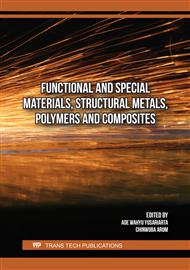[1]
S. Kalpakjian and S. R. Schmid, Manufacturing Engineering and Technology. Prentice Hall, 2010.
Google Scholar
[2]
E. Sasimowski, Ł. Majewski, and M. Grochowicz, "Analysis of Selected Properties of Injection Moulded Sustainable Biocomposites from Poly(butylene succinate) and Wheat Bran," (in eng), Materials (Basel), vol. 14, no. 22, Nov 20 2021.
DOI: 10.3390/ma14227049
Google Scholar
[3]
M. Kurt, Y. Kaynak, O. S. Kamber, B. Mutlu, B. Bakir, and U. Koklu, "Influence of molding conditions on the shrinkage and roundness of injection molded parts," The International Journal of Advanced Manufacturing Technology, vol. 46, no. 5, pp.571-578, 2010/01/01 2010.
DOI: 10.1007/s00170-009-2149-x
Google Scholar
[4]
Y. Wang, L. Y. Chen, X. M. Yang, Y. Zhao, Z. Y. Xu, and X. P. Wang, "Numerical Optimization of Shrinkage and Warpage on the Injection Molding Process Parameters of Electrical Connector," Applied Mechanics and Materials, vol. 868, pp.183-191, 2017.
DOI: 10.4028/www.scientific.net/AMM.868.183
Google Scholar
[5]
D. Kusić and A. Hančič, "Influence of molding conditions on the shrinkage and warpage behavior of standardized test specimens," AIP Conference Proceedings, vol. 1779, no. 1, p.020017, 2016.
DOI: 10.1063/1.4965468
Google Scholar
[6]
T. Chang and E. Iii, "Shrinkage behavior and optimization of injection molded parts studied by the Taguchi method," Polymer Engineering & Science, vol. 41, pp.703-710, 05/01 2001.
DOI: 10.1002/pen.10766
Google Scholar
[7]
W. Sui and D. Zhang, "Four Methods for Roundness Evaluation," Physics Procedia, vol. 24, pp.2159-2164, 2012/01/01/ 2012.
DOI: 10.1016/j.phpro.2012.02.317
Google Scholar
[8]
Autodesk. "Quality prediction result." https://help.autodesk.com/view/MFAA/2023/ENU/ ?guid=GUID-4F115A68-4469-4414-BB62-80B341FAC3AF (accessed 2023).
Google Scholar
[9]
D. Palanisamy and P. Senthil, "Application of Grey-Fuzzy Approach for Optimization of CNC Turning Process," Materials Today: Proceedings, vol. 5, no. 2, Part 2, pp.6645-6654, 2018/01/01/ 2018.
DOI: 10.1016/j.matpr.2017.11.321
Google Scholar
[10]
A. Mufarrih, B. O. P. Soepangkat, and I. Krisnanto, "Multi Response Optimization Using Taguchi-Grey-Fuzzy Method in Drilling of Kevlar Fiber Reinforced Polymer (KFRP) Stacked," Applied Mechanics and Materials, vol. 836, pp.179-184, 2016.
DOI: 10.4028/www.scientific.net/AMM.836.179
Google Scholar
[11]
W.-C. Chen, G.-L. Fu, P.-H. Tai, and W.-J. Deng, "Process parameter optimization for MIMO plastic injection molding via soft computing," Expert Syst. Appl., vol. 36, no. 2, p.1114–1122, 2009.
DOI: 10.1016/j.eswa.2007.10.020
Google Scholar
[12]
I. Soejanto, "Desain eksperimen dengan metode taguchi," Yogyakarta: Graha Ilmu, 2009.
Google Scholar
[13]
A. Kościuszko, D. Marciniak, and D. Sykutera, "Post-Processing Time Dependence of Shrinkage and Mechanical Properties of Injection-Molded Polypropylene," (in eng), Materials (Basel), vol. 14, no. 1, Dec 23 2020.
DOI: 10.3390/ma14010022
Google Scholar
[14]
P. J. Ross, Taguchi Techniques for Quality Engineering: Loss Function, Orthogonal Experiments, Parameter and Tolerance Design. McGraw-Hill, (1996)
Google Scholar


